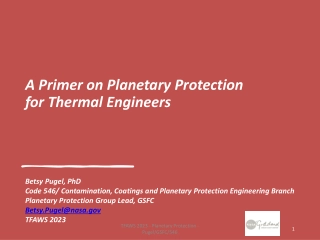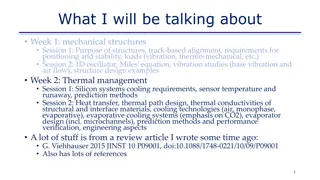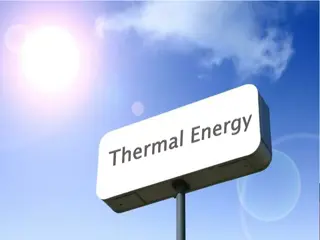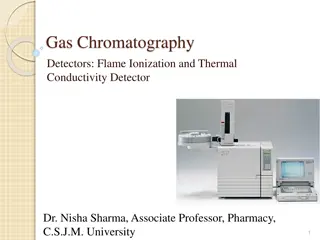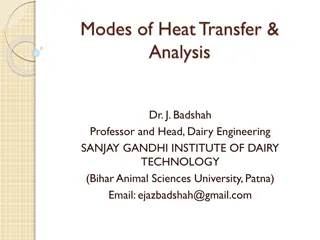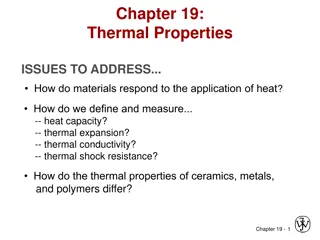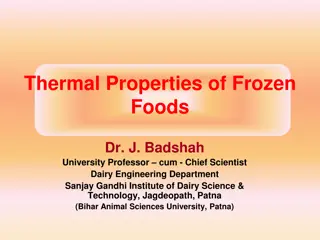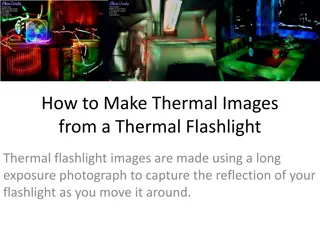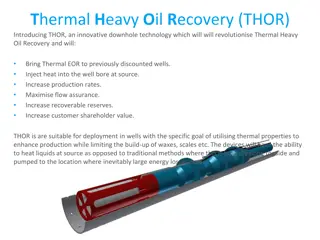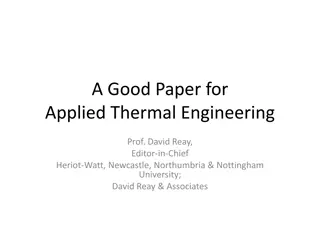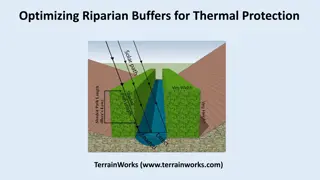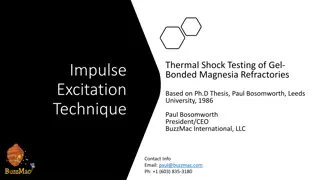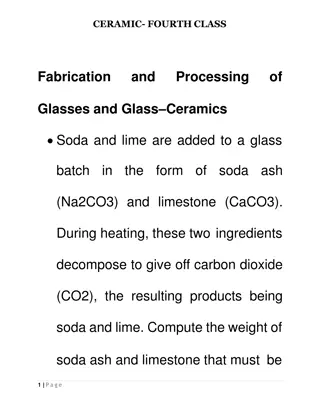
Thermal Balance in Spacecraft Operations
Explore the concept of thermal balance in spacecraft operations, including how spacecraft are heated, methods of heat dissipation/generation, and the importance of maintaining a stable temperature environment. Delve into the sources of heat in space such as the Sun, nearby objects, internal planetary heating, and more. Learn about calculating heat input/output based on distance from the Sun and cross-sectional area, as well as the various heat transfer processes in space environments.
Download Presentation

Please find below an Image/Link to download the presentation.
The content on the website is provided AS IS for your information and personal use only. It may not be sold, licensed, or shared on other websites without obtaining consent from the author. If you encounter any issues during the download, it is possible that the publisher has removed the file from their server.
You are allowed to download the files provided on this website for personal or commercial use, subject to the condition that they are used lawfully. All files are the property of their respective owners.
The content on the website is provided AS IS for your information and personal use only. It may not be sold, licensed, or shared on other websites without obtaining consent from the author.
E N D
Presentation Transcript
Introduction [See F&S, Chapter 11] Introduction [See F&S, Chapter 11] We will look at how a spacecraft gets heated How it might dissipate/generate heat The reasons why you want a temperature stable environment within the spacecraft. Understanding the thermal balance is CRITICAL to stable operation of a spacecraft.
Object in space (planets/satellites) have a temperature. Q: Why? Sources of heat: Sun Nearby objects both radiate and reflect heat onto our object of interest. Internal heating planetary core, radioactive decay, batteries, etc. Heat loss via radiation only (heat can be conducted within the object, but can only escape via radiation).
To calculate the heat input/output into our object (lets call it a Spacecraft) need to construct a balance equilbrium equation . First: what are the main sources of heat? For the inner solar system this will be the Sun, but the heat energy received by our Spacecraft depends on: Distance from Sun The cross-sectional area of the Spacecraft perpendicular to the Sun s direction
At 1 AU solar constant is 1378 Watts m-2 (generally accepted standard value). Varies with 1/(distance from sun)2 Consider the Sun as a point source, so just need distance, r. Cross-sectional area we know for our Spacecraft (or any given object).
The radiation incident on our Spacecraft can be absorbed, reflected and reradiated into space. So, a body orbiting the Earth undergoes: Heat input: Direct heat from Sun Heat from Sun reflected from nearby bodies (dominated by the Earth in Earth orbit). Heat radiated from nearby bodies (again, dominated by the Earth)
Heat output Solar energy reflected from body Other incident energy from other sources is reflected Heat due to its own temperature is radiated (any body above 0K radiates) Internal sources Any internal power generation (power in electronics, heaters, motors etc.).
Key ideas Albedo Albedo fraction of incident energy that is reflected Absorptance by incident energy Absorptance fraction of energy absorbed divided Emissivity ( T radiates a predictable amount of heat. A real body emits less (no such thing as a perfect blackbody). Emissivity, , = real emission/blackbody emission Emissivity (emittance emittance) ) a blackbody at temperature
Need to consider operational temperature ranges of spacecraft components. Components outside these ranges can fail (generally bad). Electronic equipment (operating) Microprocessors Solid state diodes Batteries Solar cells Fuel (e.g. hydrazine) infra-red detectors Bearing mechanisms Structures Electronic equipment (operating) - -10 to +40 -5 to +40 C -60 to +95 C -5 to +35 C -60 to +55 C +9 to +40 C -200 to -80 C -45 to +65 C -45 to +65 C 10 to +40 C C
How to stay cool? Want as high an albedo as possible to reflect incident radiation Want as low an absorptance as possible Want high emissivity to radiate any heat away as efficiently as possible
Balance equation for Spacecraft equilibrium temperature is thus constructed: Heat radiated from space = Direct solar input + reflected solar input +Heat radiated from Earth (or nearby body) +Internal heat generation We will start to quantify these in a minute...
Heat radiated into space, J, from our Spacecraft. Assume: Spacecraft is at a temperature, T, and radiates like a blackbody ( T4W m-2, = Stefan s constant = 5.670 x 10-8J s-1m-2K-4) It radiates from it s entire surface area, ASC we will ignore the small effect of reabsorption of radiation as our Spacecraft is probably not a regular solid. Has an emissivity of . Therefore: J = ASC T4
Now we start to quantify the other components. Direct solar input, need: JS, the solar radiation intensity (ie., the solar constant at 1 AU for our Earth orbiting spacecraft). A Sthe cross-section area of our spacecraft as seen from the Sun (A S ASC!) The absorbtivity, , of our spacecraft for solar radiation (how efficient our spacecraft is at absorbing this energy) Direct solar input = A Direct solar input = A S S J JS S
Reflected solar input. Need: JS the solar constant at our nearby body. A Pthe cross-sectional area of the spacecraft seen from the planet Asorbtivity, , for spacecraft of solar radiation The albedo of the planet, and what fraction, a, of that albedo is being seen by the spacecraft (function of altitude, orbital position etc.) Define: Ja= albedo of planet x JSx a Reflected solar input = Reflected solar input = A A p p J Ja a
Heat radiated from Earth (nearby body) onto spacecraft. Need: Jp= planet s own radiation intensity F12, a viewing factor between the two bodies. Planet is not a point source at this distance. A Pcross-sectional area of spacecraft seen from the planet. Emissivity, , of spacecraft Heat radiated from Earth onto spacecraft= A Q: Why and not ? is wavelength (i.e., temperature) dependent. Planet is cooler than Sun and at low temperature = ) Spacecraft internally generated heat = Q Heat radiated from Earth onto spacecraft= A P P F F12 12J JP P
So, putting it all together... S p p = + + + 4 A T A J A J A F J Q 12 SC S a P Divide by ASC (and tidy) to get: = P P A A A Q + + + 4 S T J J F J 12 S a P A A A A SC SC SC SC Therefore / term is clearly important.
Of the other terms, JS, Ja, JPand Q are critical in determining spacecraft temperature. Q: How can we control T? (for a given spacecraft). In a fixed orbit JS, Ja, JPare all fixed. Could control Q Could control / (simply paint it!) So select / when making spacecraft. Table on next slide gives some values of / .
Comment: spherical spacecraft with passive heat control. Comment: All this assumes a uniform Some components need different temperature ranges (are more sensitive to temperature) so active cooling via refrigeration, radiators probably required for real-life applications.

